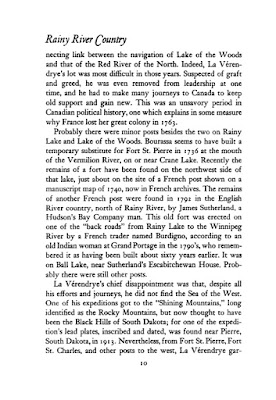Day Four
On the morning of final day of Voyageur’s National Park trip I checked out of my hotel, and headed out before daylight. I had most of a day to do some last minute sight-seeing in the park and International Falls. I decided to drive to Rainy Lake to watch the sunrise and maybe see some wildlife.
The whitetail deer in the area tend to hangout in populated areas around visitor centers and lodges. I think I saw about 30 deer during the first hour of sunlight. One local resident told me he believes the deer stay near people to avoid wolves in the area.
Driving slowly in the park gave me plenty of time to reflect on my Genealogy Roadtrip.
For nearly two years I had given serious thought to this trip before making a commitment. The online pictures of the area suggested that the park was more committed to family vacations and house boating than to preserving wilderness and voyageur history.
I seriously considered driving my motorhome and towing my 14’ Old Town Hunter Canoe, but the 4500 mile roundtrip would have taken at least six days if I could average 750 miles/day. That’s a tall order for an old guy.
As it turned out I really regret not having driven. I never actually got to paddle a canoe anywhere in Voyageur’s National Park because of the discourteous and lackadaisical attitude of outfitters and lodge employees.
In the end I had a lot of disappointments during the trip, and the sad truth is that America, its parks, and its people have become progressively worse during the past couple of decades.
Sadly, there is also a lack of respect and recognition for the knowledge and experience of older citizens. America has become an increasingly toxic place for ‘Old Gringos.’
The cold, rainy, and dark last morning of my visit to Rainy Lake pretty much summed up my experience of the place.
On the positive side the boreal forest is always beautiful, and little glimpses of its treasures made the trip somewhat worthwhile for me.
I had one more place to visit in International Falls, so I bid ado to Voyageur’s National Park, and set a course for the Koochiching County Historical Museum where I hoped to learn more about the history of the area.
The Koochiching County Historical Museum was definitely not a disappointment. There I met Edgar Oerichbauer the longtime curator and director of the museum, and found a kindred spirit who shares my reverence for fur trade and voyageur history.
When I told Edgar about my gift of a copy of my 4th great-grandfather’s voyageur contract to the park ranger, and the ranger’s distinct lack of enthusiasm about my gift, he said, "I wish you’d given it to us instead." When I got home I emailed him copies of several voyageur engagement contracts for my ancestors.
Finally, I drove down to Rainy River for one last look before heading out to the airport. I stood on the bank trying to imagine what this area was like 200 years ago when my voyageur ancestors passed through.
 |
|
Chippewa Indian encampment on Rainy River c. 1915
|
You can learn more about my voyageur ancestors here:
Rene Bourassa dit LaRonde (6th great-uncle) https://a-drifting-cowboy.blogspot.com/2015/08/great-uncle-rene-was-coureurs-des-bois.html
Charles Boyer (8th great-uncle) http://laprairie-voyageur-canoes.blogspot.com/2017/03/ripples-from-la-prairie-voyageur-canoes_62.html
Charles Mignier dit Lagace (6th great-uncle) https://a-drifting-cowboy.blogspot.com/2016/08/uncle-charles-lagasse-on-columbia.html
Charles Boyer Jr. (1st cousin 8x removed) https://a-drifting-cowboy.blogspot.com/2016/06/cousin-charles-boyer-was-norwester.html
François Rivet (2nd cousin 7x removed) https://a-drifting-cowboy.blogspot.com/2016/08/cousin-francois-rivet-mountain-man.html
Pierre Pinsonneau (5th great-uncle) https://a-drifting-cowboy.blogspot.com/2016/08/uncle-pierre-norwester-goes-to-portage.html
 |
| Signed by company rep. Alex MacKinzie |
Joseph Vielle dit Cosse (5th great-uncle) https://a-drifting-cowboy.blogspot.com/2016/08/great-uncle-joseph-nwc-voyageur-who.html
Andre Mignier dit Lagace (1st cousin 6x removed) https://a-drifting-cowboy.blogspot.com/2016/08/cousin-andre-lagasse-was-interpreter.html
Michel Vielle dit Cossé (5th great-uncle) http://laprairie-voyageur-canoes.blogspot.com/2017/03/ripples-chapter-three-vielle-family.html
Francois Pinsonneau (5th great-uncle) http://laprairie-voyageur-canoes.blogspot.com/2017/03/ripples-chapter-three-pinsonneau-family.html
Jean-Baptiste Meunier dit Lagace (4th great-grandfather) https://a-drifting-cowboy.blogspot.com/2017/01/great-grandfather-canoes-to-lac-le-pluie.html
THE TRIP:
THE TRIP:
Genealogy Roadtrip to Voyageurs National Park - Goals
Genealogy Roadtrip to Voyageurs National Park - Part II
Genealogy Roadtrip to Voyageurs National Park - Part III
Genealogy Roadtrip to Voyageurs National Park - Part IV
3 1/2 min. YouTube Video... 'Visiting Voyageur Ancestor Spirits'
https://www.youtube.com/watch?v=B2NPANdZaGU
OUR ANCESTORS:
LaPrairie Voyageur Canoes...
http://laprairie-voyageur-canoes.blogspot.com/2017/10/ripples-from-la-prairie-voyageur-canoes.html
http://laprairie-voyageur-canoes.blogspot.com/2017/10/ripples-from-la-prairie-voyageur-canoes.html






















































